
Annual Bulletin 2, 1978-1979
Home
Français
Introduction
History
Annual Index
Author &
Subject
Credits
Contact
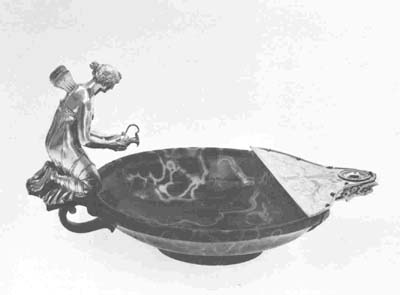
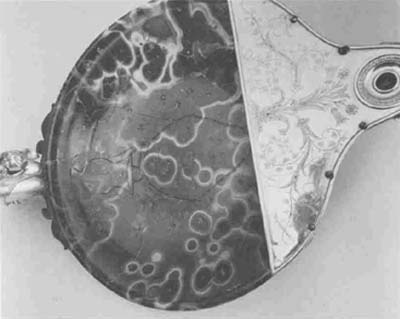
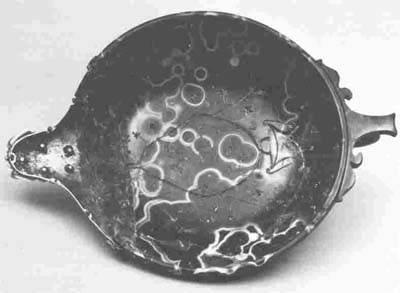
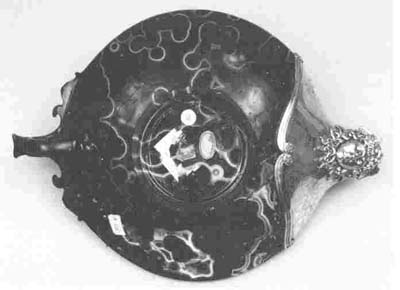
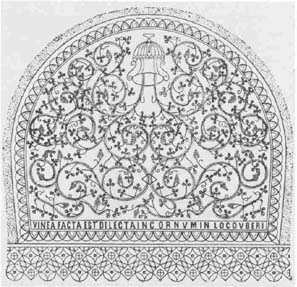
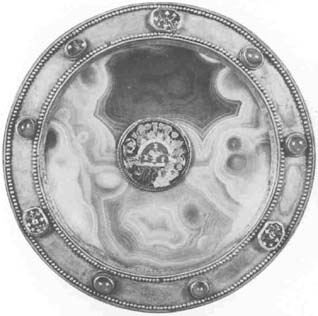
A Christianized and
Neo-Classicized Roman tazza
by Philippe Verdier
Article en français
Pages 1 | 2
| 3
The National Gallery of Canada acquired in 1976 a work of art extremely interesting
because of its beauty and because of the series of alterations it underwent.
It is a bowl with handles, or tazza, harking back to the High Roman
Empire, made of ocellate brown agate, (1) of the kind named "Indian"
by Pliny the Elder. (2) (See figs 1 to 4.) It was transformed into a liturgical
vessel in the Early Christian era and ultimately, under Napoleon I, adapted
as an oil lamp, mounted in silver gilt and ormulu; as a result, it received
the honour of being shown in the 1972 London exhibition, The Age of
Neo-Classicism, the fourteenth exhibition of the Council of
Europe. (3)
The tazza was then the property
of Mr Fabrizio Apolloni of Rome. It had been in the collection of J. Pierpont
Morgan. After Congress had passed the Payne-Aldrich Act in 1909 (exempting
works of art from import duty), Morgan decided to bring back to the United
States the riches he had piled up in Europe. From the end of 1911 to 31
March 1913 when Morgan died, in Rome, 351 crates were shipped from London
to New York. The fabulous collection, comprising more than 4,100 works
of art, was stored in the basement of the Metropolitan Museum of Art.
The entire collection was put on exhibition in the museum in June 1914.
But only some 3,000 items were permanently added to the Metropolitan Museum
collections. The rest, of which the tazza was a part, was sold to
defray the cost of succession duties. (4)
The tazza has the shape of a
flat cup on a foot with two handles, one of them broken together with its
attachment. The neo-classical mounts hide the damage; the broken agate
has been repaired. No Latin word accurately describes the shape of the tazza; patera
is the nearest to it, because it indicates a shallow
vessel with a broad opening, (5) although the Latin patera was technically
a bowl without handles, used for pouring blood or wine libations
over an altar. However, a patera, or flat glass chalice, of the
fourth century A. D., adorned with s-shaped handles attached to the lip,
was found in the catacombs of Saint Calixtus in the Roman countryside. (6)
The National Gallery tazza could as well be termed a kylix, or
flat-footed cup. It belongs to the category of
luxury vases, made for display without a precise religious or utilitarian
function, and corresponding to Alexandrian taste.
Alexandria and the Near East transmitted
to Rome the fashion of luxury vessels. They were made of precious metals
or gems, either mounted in gold or silver, or left plain. Quoting the philosopher
and historian Posidonios, who was born in Apamea, Syria, around 135 B. C.,
Athanaeus notes in his Deipnosophists the existence of drinking
glasses of various sizes, skyphoi, made of onyx. (7) Pliny the Eider
emphasized that such vessels were introduced into Rome by Pompey's triumphal
procession, which carried through the streets of Rome the treasure looted
by Pompey after his victory over Mithridates in 61 B. C. (8)
According to Appian, it took a full month before the quaestor was able
to draw up the inventory of the spoils brought back by Pompey. (9) The gem
collection (dactyliotheca - etymologically, a collection of rings),
was deposited in the treasury of the Temple of Jupiter on the Capitol.
There were enough gems and gold vases paraded during Pompey's triumphal
march to fill nine dressers. (10) Afterwards, six dactyliothecae were
dedicated by Caesar in the Roman temple of Venus Genitrix, and another
one by Octavia's son, Marcellus, in the Temple of Apollo on the Palatine. (11)
After the victory at Actium in 31 B. C., the Ptolemies' treasure fell into
the hands of Augustus (12); this treasure was fabulously rich both in vases
cut from precious or semi-precious stones, sometimes carved with mythological
scenes, and in rock crystals. After the establishment of the Pax Romana
under Augustus, gem cutters (gemmarit) flocked from Greece,
Egypt and the Near East to the western provinces of the Roman Empire. They
set up guilds and founded hereditary workshops in Taranto and Aquileia,
and later at Cologne and Trier. (13)
A precious clue for dating the tazza
is provided by the surviving handle. It is fashioned as a ring
for the thumb to thread into, topped by a ledge for the index and
middle fingers to rest on, and ending with a talon. A graceful scroll
connects it with the tazza lip. Smaller but similar handles, intended
to be held between thumb and forefinger only, characterize skyphoi made
in Asia Minor as early as the first-century B. C. (14) The tazza handle
is almost identical in shape to the handle on a contemporary rock crystal
skyphos from Alexandria, in the San Marco treasure in Venice
(fig. 5); on a chalcedony
tazza dating from the Early Roman Empire at the Pitti Palace in Florence
(15); and on a chalice in the Bamberg cathedral treasure, which is
a rock crystal skyphos with mountings of the eleventh century.
The two-handled tazza of the National Gallery
corresponds to a type of vessel that appeared during Augustus's reign
and of which there are examples in goldsmith's art: for instance, the
silverware from Boscoreale in the Louvre, the cup from Alesia and the two-handed
cup in chased silver found near Hildesheim in 1868. (16) The big agate tazza
in the Weltliche Schatzkammer at the Hofburg in Vienna measures seventy-five
centimeters in diameter compared with the National Gallery tazza which
measures 42.5 centimeters (fig. 6). The Vienna tazza has two
handles cut out as vine scrolls in a dried up style whith, corroborated
by the incised name of its maker, Flabius Aristo, a gemmarius of
Trier, indicates a date in the early fourth-century, or during the reign
of Constantine the Great.
In post-medieval times, after 1564 (the date of the first documented mention
of the Vienna tazza) and maybe
already in the Middle Ages, the inscription Fl(a)b(ius) Aristo
Tr(eviris) f(ecit) xx p(ondon) was deciphered as B. Christo Ri
xxpp, a
misreading which anachronistically christianized the cup. This
misinterpretation explains why the Vienna tazza was used for baptizing the archdukes
of Austria, as is stated in the inventory of the Schatzkammer, drawn up
in 1677. (17)
Next Page | National
Gallery tazza
1 | 2
| 3
Annual Index | Author & Subject | Credits | Contact
This digital collection
was produced under contract to Canada's Digital Collections program,
Industry Canada.
"Digital
Collections Program, Copyright
© National Gallery of
Canada 2001"